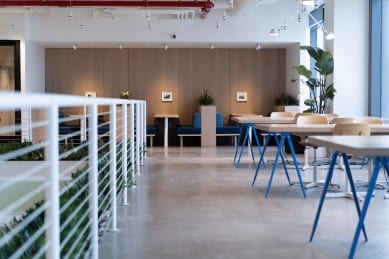
For decades, CRE teams have wished for tools that would provide accurate, valid, real-time space utilization data about their portfolios. Technology is finally able to make that possible.
Traditionally, CRE teams have been able to work with space allocation data, but that kind of information alone shouldn’t be relied upon to make space planning and space management decisions. Now, teams can also use space utilization data, which offers a wealth of possibilities, but can also be overwhelming. Let’s start by defining each term:
Space allocation describes the assignments or allocations of a workplace. For example, you might have 100 desks and 75 employees assigned to them, meaning you have 25% vacancy and 75% of your desks have been allocated.
Space utilization captures real-time data of how the space is actually being used. In the scenario above, you might have 75 employees, but 10 are part of the sales team and they travel 70% of the time, four work from home one or two days a week, and six more are working on long-term projects and spend at least 50% of their time at other campuses…and so on.
In short, space allocation describes the plan or expectation, while space utilization goes a step further to describe the reality of how a workplace, or even a workspace, gets used.
The Benefits and Potential of Space Utilization Data
Now that CRE leaders can easily capture office space utilization data, they have the tools to solve problems that space allocation data alone couldn’t tackle.
Optimize the Entire Workplace
With good space utilization data on, for example, conference room usage, you’d be able to see that according to Outlook calendars, the conference rooms are booked 80% of the time, but actually in use only 30% of the time. Depending on the type of data you’re able to collect, you might also be able to see that large conference rooms are mostly used by groups of just 3-5 people. Instead of recommending the company build out more conference rooms, CRE leadership could do a number of things with this data:
- Analyze the disparity in bookings and actual use (Are people not cancelling their reservations? Why?)
- Change the structure of conference rooms (breaking up the large rooms into more smaller rooms)
- Update or create additional spaces, like soft seating areas, cafes, or kitchens/break rooms, to accommodate meetings or collaborative work
- Incorporate technology that improves the booking process or better manages the use of the space, such as sensors that automatically “cancel” the booking if they don’t register anyone in the room or check-in devices to verify the room is in use
- Implement policies that discourage people or teams from booking rooms and not using them
Build Stronger Business Cases
Space utilization data also makes it possible to plan your workplace and ensure that your floor plans, layout, and design are meant to enable your employees and encourage productivity and collaboration.
Because space utilization data is now collected through IoT devices, sensors, software, and other technology, it makes a stronger case when CRE leaders propose initiatives and plans about the space—they’re able to truly say that decisions and recommendations are backed by evidence. Getting everyone from department heads to the C-suite on board is easier when you have accurate, verifiable data.
Obstacles and Challenges
While adopting and using space utilization data can help you gain greater insights on your space and better inform decision making, there are a few things to consider before executing your plan.
Financial Considerations
There are often some significant upfront investments when it comes to new technology—whether you want building sensors, advanced entry badges, or other IoT devices or software. CRE leaders need to demonstrate that the data they collect and analyze will be accurate, valid, and valuable to the organization. Whether you implement new technology or leverage technology that you already have in place, you also need to consider its cost-effectiveness: what is the ROI of the data you’ll get?
Nevertheless, while there will be costs to purchase, install and maintain the technology, the potential savings in real estate costs might easily justify the investment.
How do you build a business case for redesigning your workplace?
(Lack of) Stability in Tech
We hear a lot about the success stories when it comes to Silicon Valley start-ups—but the reality is, the lifespan for the average new tech company is…not very long. According to industry estimates, only about 10% will last longer than five years.
One common scenario is when a company promises some incredible new technology that gets people excited. But for some reason—lack of money, the founders’ inexperience, or poor execution of the actual product development—the tech doesn’t deliver as promised.
The CRE and IT teams must do careful research and due diligence into technology companies before making significant investments and commitments if they want to see long-term value. Be sure to select a vendor that has proven experience and demonstrated ROI in your field.
Privacy Concerns and GDPR
We think it’s likely that more countries, including the US, may adopt the EU’s General Data Protection Regulations (GDPR) in the near future. This would limit the useful, valuable data that companies will be able to collect. CRE teams can still make a lot of decisions based on anonymized, aggregated data, but they may be hindered in their ability to increase productivity by co-locating certain teams or individuals, for example.
That said, we think more companies will rise to the challenge of developing tools that provide actionable data without capturing personally identifiable information (PII), or limiting its capture. Additionally, more employees may be willing to make that trade-off—allowing their employer to collect and use certain personal information—once they see how that data can be used for their best interests. With the value space utilization data promises for CRE, the use of it will only continue to grow.


